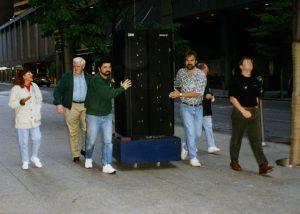Artificial Intelligence
20 Years After Deep Blue, a New Era in Human-Machine Collaboration
May 11, 2017 | Written by: Murray Campbell
Categorized: Artificial Intelligence
Share this post:
On May 11, 1997, an IBM computer called Deep Blue defeated the reigning world chess champion, Garry Kasparov, capturing the attention and imagination of the world. The six-game match lasted several days and ended with two wins for IBM, one for the champion and three draws.
The match was cast as the ultimate example of man versus machine. Yet, Kasparov himself is now a self-described proponent of artificial intelligence (AI), recently calling it a boon to humankind, “capable of providing us with endless opportunities to extend our capabilities and improve our lives.”
This view mirrors IBM’s. We too believe the promise of AI lies in its capacity to augment human abilities and intellect.
Over the last 20 years, IBM has worked to advance the field of AI. Deep Blue used algorithms to explore up to 200 million possible chess positions per second, then chose the move with the highest likelihood of success. While Deep Blue did use machine learning approaches, it relied primarily on a programmed understanding of the game of chess – 64 squares, 32 pieces and well-defined moves and goals.

IBM Deep Blue team members wheel the system through the streets of New York City to Rockefeller Center at 4:00AM, May 11, 1997.
Fourteen years after Deep Blue’s win, IBM applied AI to the more dynamic real-world challenge of Jeopardy! This represented a huge step forward from playing chess, given the quiz show could cover questions on just about anything. IBM Watson incorporated facets of AI, machine learning, deep question answering and natural language processing to play and, ultimately, bested the game’s greatest human champions.
Much was learned in pitting AI systems against human opponents. Most significant is the realization that AI can best be used to fill the gaps in human ability, and vice versa. AI technology has evolved significantly, but AI systems are not nearly as good as humans at common sense reasoning or thinking creatively and strategically. Such gaps will likely remain for decades to come.

The Deep Blue Team 1997: Chung-Jen Tan, Murray Campbell, Joe Hoane, Feng-Hsiung Hsu, and Jerry Brody.
Therefore, we must factor the abilities and limitations of both machines and humans to create combined systems that enable outcomes better than what either could achieve alone. The promise of AI lies in the combination of man and machine.
IBM Watson shows what is possible. The cognitive system has been applied to real-world challenges such as helping doctors diagnose patients, teachers to provide personalized curriculum to students, tax preparers to help clients file returns and oil and gas engineers to ensure compliance.
IBM Watson is on track to be used in some form by a billion people by the end of 2017. In the next five years, many important decisions, be they business or personal, will be made with the assistance of a cognitive system like Watson.
IBM’s goal is to accelerate human ability to create, learn, make decisions, and think, opening a new era in human-machine collaboration.

Distinguished Research Staff Member, Cognitive Computing, IBM
Making the workplace safe for employees living with HIV
The recent promising news about Covid-19 vaccines is in sharp contrast to the absence of a vaccine for HIV, despite decades of research. Unlike Covid-19 with a single viral isolate that shows minimal diversity, HIV circulates in a wide range of strains that so far have proven impervious to a single vaccine. Fortunately, more people […]
Call for Code for Racial Justice Needs You: Join the Movement
IBM has never avoided taking on big challenges. At IBM, we are privileged to drive impact at scale. We take on challenges that transform our clients, impact people’s lives and innovate for future generations as we strive to effect systematic societal change. Over the course of our 109-year history, the evidence has become clear that […]
A New Wave: Transforming Our Understanding of Ocean Health
Humans have been plying the seas throughout history. But it wasn’t until the late 19th century that we began to truly study the ocean itself. An expedition in 1872 to 1876, by the Challenger, a converted Royal Navy gunship, traveled nearly 70,000 nautical miles and catalogued over 4,000 previously unknown species, building the foundations for modern […]





























